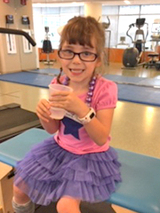Selective dorsal rhizotomy surgery for cerebral palsy: Laurel's story
Selective dorsal rhizotomy surgery for cerebral palsy: Laurel's story

When spasticity from cerebral palsy left Laurel in pain and with difficulty moving, the team at the Cerebral Palsy Program worked with CHOP neurosurgeons to perform a life-changing surgical procedure.
Renee was 30 weeks pregnant when she went into labor. Twenty minutes after arriving at the hospital, her daughter Laurel was born.
Laurel weighed just 3.5 pounds. She was transferred immediately to the NICU in a nearby hospital. The next day, her lungs collapsed and she had to be resuscitated. The event caused a grade IV bleed on her brain that resulted in hydrocephalus, a buildup of fluid in the cavities in the brain.
Together at last
Laurel spent a month in the local hospital before her parents requested she be transferred to Children’s Hospital of Philadelphia (CHOP). CHOP is one of the top pediatric hospitals in the country and, fortunately, very close to the family’s home in South Jersey.
At CHOP, the family was able to bond in a way they couldn’t in the previous hospital. The care team encouraged Renee and her husband, John, to hold Laurel and care for her despite all of the tubes and wires connected to her, and helped them do skin-to-skin care.
“It really felt like she became our child there,” says Renee. “It was an amazing experience.”
During her stay at CHOP, Laurel underwent surgery to have a shunt placed in her brain to relieve the pressure caused by the buildup of fluid. One-and-a-half weeks later, at 2 months old, she was discharged home.
Diagnosis of cerebral palsy
While going home was a step in the right direction, Laurel’s struggles unfortunately weren’t over. A grade IV brain bleed can cause significant brain injury. When she was 8 months old, Laurel had an MRI at CHOP that confirmed she had central vision impairment, optic nerve atrophy and cerebral palsy.
The family was connected with CHOP’s Cerebral Palsy Program, an interdisciplinary program that includes physicians, therapists and other specialists. Laurel immediately began physical and occupational therapy to help rewire her brain and override the brain damage. Initially she wasn’t hitting any milestones, like rolling over. But when she turned 1, her mother says she blossomed.
“As soon as she turned 1, you could see it in her eyes like she was actually seeing the world,” says Renee.
Selective dorsal rhizotomy surgery for spasticity
Despite her progress, Laurel struggled more and more with spasticity and painful spasms in her legs as she grew. The majority of children with cerebral palsy have impairments in muscle tone, such as spasticity where muscles tighten involuntarily, causing abnormal movements and stiffness.
Spastic muscles do not grow normally, and over time, permanent muscle contracture (shortening) and deformity can develop. This can lead to hip displacement or dislocation, gait abnormalities, or neuromuscular scoliosis, among other impairments. In children with cerebral palsy, spasticity typically worsens with growth due to the muscles’ inability to keep up with bone growth. This can make it more difficult for a child who is ambulatory to continue to walk without deviation.
The CHOP team tried a variety of treatments to alleviate Laurel’s spasticity, including BOTOX® injections, oral medication, bracing and casting, all of which had temporary effects and were becoming less effective over time to improve her spasticity. This was making it more difficult for Laurel to fit comfortably in braces and to move independently.
Another treatment option called selective dorsal rhizotomy (SDR) involves cutting a portion of the dorsal roots of spinal nerves as they leave the spinal column to result in a permanent reduction in muscle tone, such as spasticity. Not all patients with spasticity are good candidates for this surgery. SDR is a permanent surgery that requires very specific consideration for selection as well as intensive rehabilitation for up to one year post-surgery. SDR requires a multidisciplinary team to ensure good selection and good functional outcomes.
The SDR team at CHOP includes rehabilitation medicine, neurosurgery, orthopedics, and physical and occupational therapy. Together, the team evaluated Laurel’s spasticity, motor control, strength and muscle flexibility, current functional skills, orthopedic considerations, and family goals. Ultimately they decided that she was a good candidate for this tone reducing surgery.
A life-changing treatment

Less than six months after the surgery, 5-year-old Laurel’s progress is unprecedented.
“This surgery changed her life,” says Renee. “Her legs are so much looser now, and she’s not in pain. And she doesn’t need any more BOTOX shots.”
Laurel’s physical therapists said it would be a year before she would be able to walk independently in her walker like she was before surgery, but she is already doing it. The surgery also improved her fine motor skills and even her speech and volume of her voice.
“She’s not fighting all of this spasticity in her body,” says Renee. “She’s just so much more confident and social and verbal. She’s a different child.”
She goes to CHOP three times a week for physical therapy to work on muscle strength, motor control and functional skills, such as walking, but her mom says she doesn’t collapse when she gets home like she did before the surgery.
Laurel loves being independent and helping out on her parents’ farm, especially their curbside farmer’s market in the summer.
She’s involved in special needs dance classes, sled hockey, cheerleading and soccer, and therapeutic horseback riding. She is in kindergarten and loves it.
“We love CHOP,” says Renee. “Everybody is so kind. Laurel has had such great care. We are just extremely happy with everything.”